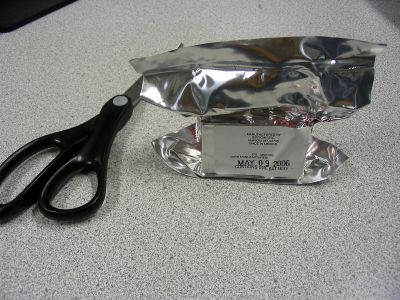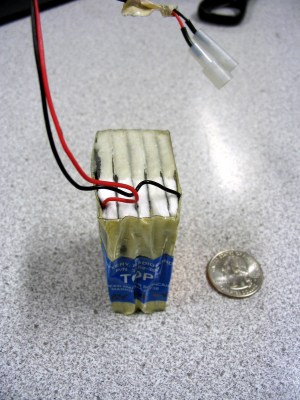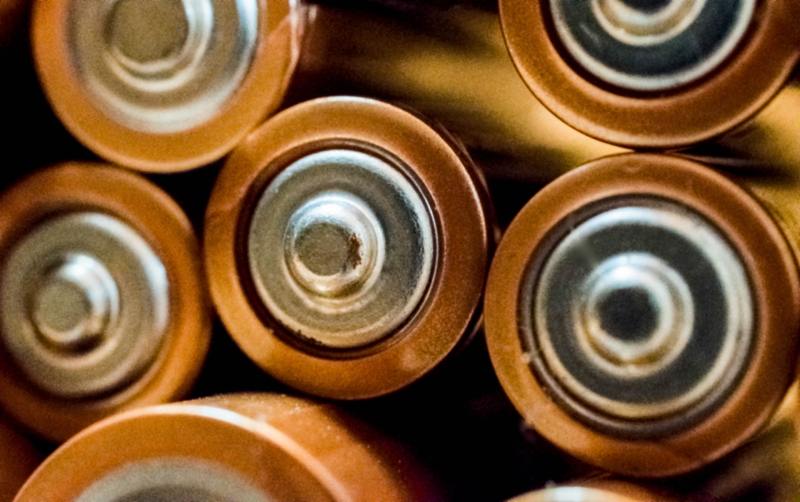Most of the batteries we use these days, whether rechargeable or not, are generally self-contained affairs. They come in a sealed package, with the anode, cathode, and electrolyte all wrapped up inside a stout plastic or metal casing. All the reactive chemicals stay inside.
However, a certain class of magnesium batteries are manufactured in a dry, unreactive state. To switch these batteries on, all you need to do is add water! Let’s take a look at these useful devices, and explore some of their applications.
Just Add Water

Magnesium water-activated batteries come in a variety of types and formats, but the various styles available all share some common attributes. They all use a magnesium anode, and rely on aqueous solutions as the electrolyte. Typical selections involve fresh water or seawater, though custom preparations can be used to vary the battery’s performance characteristics.
The main benefit of these batteries is that they can be produced in an entirely “dry” fashion. The magnesium anode and the various salt cathodes used are all solid-state materials. Without the water electrolyte in place, they can happily sit on the shelf for years without degrading. That’s a big benefit over the traditional batteries we use every day, which start the self-discharge process as soon as they’re manufactured. Magnesium batteries inherently have high self-discharge, too, but without the electrolyte in place, the battery isn’t complete, and it simply doesn’t happen. However, this does mean they’re single-use batteries that typically run for minutes to hours at the most.
The batteries are available in a range of chemistries, with magnesium-silver chloride batteries the best choice for performance applications. In practice, they typically offer power densities of up to 100 to 150 Wh/kg, on a par with lithium ion batteries, which can deliver 100 to 265 Wh/kg. Alternative chemistries are often chosen for their lower cost, with copper chloride and lead chloride among the more commonly used. Cells built with these cathode materials are much cheaper thanks to the lack of silver content, but can’t deliver the same power. Typically, they come in around 50 to 80 Wh/kg, and can’t deliver the same current as silver chloride-based cells. Depending on the chemistry, open-circuit voltages range from approximately 1.0 to 1.7 V, with higher voltages achieved by stacking many cells together.
Different Configurations

Water can be added to the battery in a variety of ways, depending on the desired application. So-called “dunk” batteries have the anodes and cathodes separated by porous, absorbent membranes. They can simply be dunked in a bucket of water to activate them, or filled with water manually, and typically run for several hours. Dunk batteries are often used on radiosondes and other equipment that benefits from a battery design with great shelf life and no heavy metal content, as they often end up left in the environment.
They’re generally stored in hermetically-sealed packs with a dessicant for good measure. When needed, the pack can be opened, and the battery juiced up, and it’s ready to go. They’ll run as long as the electrolyte is present or the cathode and andoe have ions left to give.
When used in extreme conditions, the electrolyte can boil off or freeze, and the battery will cease to deliver electricity. However, the heat generated from the battery’s own chemical reaction can sometimes provide enough heat to stave off freezing, making these batteries capable in low temperature conditions.
Immersion batteries are intended for use fully-submerged, as their name implies. Applications typically involve equipment for maritime emergencies. In these roles, the long stable shelf-life pays off, and there’s typically abundant water around to serve as an electrolyte. They’re commonly used to power emergency lights on life jackets carried in airliners, with a small quantity of salt often included in the battery to enable good performance even if the wearer lands in a freshwater lake. Other uses include power for radios and beacons on lifeboats, as well as sonobuoys, which spend their working life underwater.

The highest-performance water-activated batteries are of the forced-flow type, primarily used to power propulsion and electronics in torpedos. These take advantage of the fact that the torpedo’s forward motion can force fresh salt water through the battery, continually replenishing the electrolyte. This also serves to cool the battery, keeping it at a stable temperature for best performance.
Forced-flow magnesium-silver chloride batteries have been built in configurations of hundreds of cells in series, delivering tens to hundreds of kilowatts of power. Run times are typically on the order of 5-15 minutes, which is usually more than long enough for a torpedo to find its target and explode. These batteries took off in earnest in the wake of World War II, though have slowly been phased out by other solutions in more modern hardware.
Other obscure uses exist for these batteries, too. Smart pills exist that feature a tiny magnesium-copper cell inside. Upon coming into contact with stomach acid, the cell begins to provide electricity to a tiny circuit that sends a radio message indicating the pill has begun digestion. The cell itself is digested like any other minerals in the stomach, and the transmitter circuit is passed out of the body as waste.
Fit For Purpose
These batteries aren’t something that most of us would use on a daily basis. Their method of activation is comparatively messy compared to conventional batteries, and most of us don’t need a battery to maintain peak performance after sitting on a shelf for five or ten years. However, in a wide range of scientific, military, and industrial contexts, they’re incredibly useful. In these contexts, where it’s important to have a battery that’s ready to go at the drop of a hat after sitting for a long time, it’s hard to argue with the capability of magnesium water-activated batteries.
Headline photo: “Close-up Photo of Batteries” by Hilary Halliwell. Thumbnail image: “dead batteries” by John Seb Barber















It’s a long time since chemistry class, but would it be interesting to store power at home from solar?
Not as a day to day battery but rather store the huge excess of energy in summer to compensate for the lower performance in winter.
Lithium battery will be to costly to store big amount of energy + not that safe compared to 2 powder in a bin?
There was that one invention that turned out carbon powder by bubbling CO2 and electricity through tin and gallium. It collects as flakes on top. Then there’s various electrochemical cells that do ethylene.
Example: https://phys.org/news/2022-10-bifunctional-ionomers-electrolytes-ethylene-carbon.html
>most of us don’t need a battery to maintain peak performance after sitting on a shelf for five or ten years.
But it sure would be nice, seeing that it’s often difficult to find replacement batteries for electronics that are out of production. Buy two, keep one for later.
That’s why I try to buy devices that take standard replaceable cells. Otherwise the useful lifespan of the device is no longer than the shelf-life of its batteries. I have wireless headphones that I’ve used for 15 years now by replacing the NiMH cells – twice – but my smartphone is 5 years old and they just don’t stock the batteries anymore. What’s the point of having a replaceable battery if you can’t buy any?
I don’t like the high self discharge rate of most NiMH cells. If the smarphone has a replaceable battery at all you normally get replecements and be it from Aliexpress.
Last time I tried to buy something from Aliexpress, I got redirected to a foreign payment processor that wanted my social security number. I didn’t need the stuff that much.
There’s a variation of this used in military applications where a munition needs a long, long shelf life, but then demands a lot of power for a short time. Think something like a missile that sits in storage for years or decades but then suddenly needs kilowatt level power to drive actuators and radar seekers.
In this case, the battery is a closed, dry, unit, with the electrolyte in a sealed compartment. It’s activated by a squib firing to release the electrolyte and force it through the battery.
Power densities are insane, but at the cost of the battery only lasting dozens of seconds to a few minutes before reducing itself to a molten mess. Still, for this particular application, longevity is not an issue.
pyrocells are an amazing study
Often the electrolyte of this batteries is not a liquid at roomtemperature, so no sealed compartment is necessary. It is a solid, a mixture of salts, that will be molten by the pyrotechnic charge. No problem with a “molten mess” as this is blown up with the missile anyway.
I’d really like to get some D-size cells like this, to keep with my Victoreen CD V-715 survey meter. They’d be handy for the flashlights I keep near it, too. A shelf-stable D-size that would work after sitting for 10+ years, by merely adding water, is nearly ideal for such things. Wouldn’t it be embarrassing to survive a nuclear attack, only to find out your survey meter and flashlights are useless?
I kid, mostly, but I’m not afraid to admit that I picked up a few extra packs of alkaline D cells, specifically for those items, right after Putin invaded Ukraine. Still hoping I never need them, of course.
Lithium AA batteries in d cell adapters might be a good option. Some adapters will take 3 cells. In general my stuff lives on rechargeable nimh batteries or various sizes, in general.
Thanks for the suggestion! I just read the datasheet for Energizer AA Lithium cells at https://data.energizer.com/pdfs/l91.pdf and it states a 20-year shelf life. That’s pretty much perfect for my use case. I use Energizer Lithium cells in most of my portable electrical instruments already, because they tend to maintain a fairly constant voltage, but had no idea their shelf life was so good.
Well, you’ll find out 20 years later if that was actually true.
“Contents herein do not constitute a warranty and are for reference only.”
Railway signal boxes in remote areas used several large size 1 cell water activated ,long lasting (just add water when low). One unit in transparent cube, about the size 300x300x300mm.
Any clue what the chemistry is?
No idea , used in 1970 +++ on iron ore mining railway.
An Edison cell?